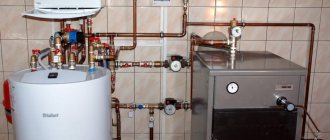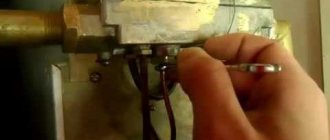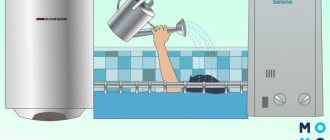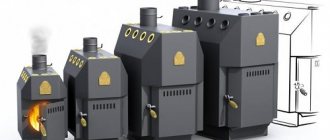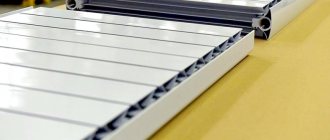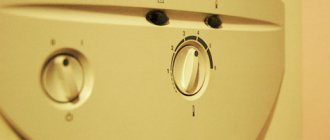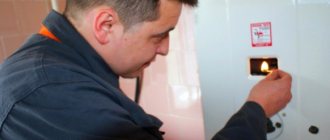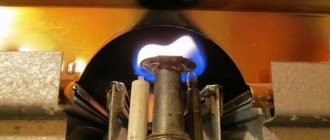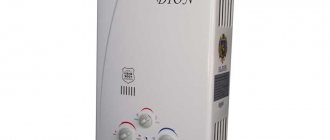Among the huge variety of water heating equipment, it can be quite difficult for the average consumer to choose the right model for their home. Knowledge of the basic principle of operation of devices, technical characteristics and design features will help to deal with this difficult issue. Together with experts from the online magazine Seti.guru, we’ll look at what a Neva gas water heater is, the criteria for choosing water heating devices, and a detailed overview of the model range.
Gas water heater Neva 4511
When a Neva gas water heater is used, its purpose
Despite the fact that many modern houses have a centralized supply of hot water, domestic gas water heaters have not lost their relevance. Such equipment provides comfortable living conditions for many ordinary people. Instantaneous heaters allow you to use hot water for domestic needs at any time convenient for consumers and do not depend on the work of municipal utilities.
Among the huge number of imported and domestic geysers on the market, it is worth highlighting Neva brand devices. The products are manufactured at the Russian enterprise Gazapparat, are equipped with modern automation and have high build quality. All models are designed taking into account the operating characteristics of domestic gas and water mains, which ensures uninterrupted operation of the equipment.
Type of combustion products removal
Atmospheric speakers are available for sale.
They discharge combustion waste directly into chimneys. The branded range of NEVA speakers is represented by VPG models from series 10 to 14, in various modifications.
Turbine columns are not connected to the chimney; they take oxygen for combustion from outside and throw combustion products there. They are intended for installation on any floor of a building in houses without chimneys. The higher price is justified by the ease of their use, since chimneys are much more expensive to build.
The general principle of operation of Neva geysers and their types
Let's consider the operating principle of Neva household water heating gas equipment and its varieties. The dispensers differ in the type of ignition of the incoming fuel, design features of the chimney, power, weight and size indicators, level of safety and the presence of additional functions.
Diagram of the Neva gas water heater
Related article:
Repair of geysers at home. In this publication we will look at the design and operating principle of geysers, the main types of malfunctions and how to eliminate them.
The operating principle of Neva brand dispensers is as follows: after opening the valve, water flows under pressure into the cavity of the water-gas unit (12). It has a membrane that acts through the stem on the valve. After it opens, the gas enters the main burner (10).
Thanks to the electrode, the gas is ignited using a pilot burner (3). In turn, the water flows into the heat exchanger pipeline (2), where it is heated to a certain temperature and supplied to all intake points in the home. The principle of construction of Neva geysers is almost the same. All models have a long warranty period (for example, for the Neva 4511 brand it is 12 years).
Gas water heaters Neva: main technical characteristics
Performance
One of the main parameters of the Neva gas instantaneous water heater, which you should pay attention to when choosing a model, is its performance. The power of the column is determined by the volume of incoming liquid that the unit is able to heat over a certain period of time.
Neva speakers come in low power - 17-20 kW, medium power - up to 26 kW and high power - up to 28 kW. For a small family, a small unit of 17-18 kW is quite suitable. If you are going to consume large volumes of hot water, you should choose models with a power of 26-28 kW.
Table 1. Relationship between column power and liquid flow
| Equipment performance, kW | Fluid flow l/min at t = +25°C | Fluid flow l/min at t= +50°C |
| 17 | 10 | 5 |
| 21 | 12 | 7 |
| 28 | 16 | 8 |
Maximum pressure
When choosing Neva water heaters, it is extremely important to take into account such a parameter as the water pressure indicator, and its minimum and maximum values should be taken into account. In the first case, it must be at least 0.19 atmospheres, otherwise the column simply will not turn on. This is especially true for old houses, in which the main pipelines are very worn out.
The maximum pressure value indicates the degree of load that the column can withstand. For gas water heaters it ranges from 9.9–11.8 atmospheres. It is known that water hammers of a certain force quite often occur in water mains, which can completely destroy the structure of the heat exchanger.
Ignition type
Modern models of speakers for household use use various types of burner ignition. A little earlier, mainly only the manual type was used, in which the gas was ignited using an open flame.
Table 2. Types of ignition of household instantaneous water heaters
| Ignition type | Image | Description |
| Ignition on a piezoelectric element | A piezoelectric element can be used to ignite gas in the columns. Ignition is carried out by pressing a button installed on the equipment panel. | |
| Electronic | The column has an autonomous power source (batteries) that powers the electronic ignition unit. | |
| Microturbine | Microturbine ignition is carried out by a hydrodynamic type generator. The water flow acts as a propulsion device and rotates the turbine, which generates current. The device is characterized by high reliability and long service life. |
Power modulation
Among the additional functionality that some Neva speaker models are equipped with is power modulation. Thanks to a special device, users can adjust the flame. The degree of heating of the heat exchanger depends on its intensity. Adjustment is carried out by decreasing or increasing the water pressure.
Using modulation, you can use water of a certain temperature, and the water dispenser will work normally, regardless of the number of floors and the pressure in the main line of the house. As practice shows, this function contributes to economical gas consumption. It also ensures the safety of users by protecting them from thermal burns.
Type of heat exchangers
Before you buy a Neva gas water heater, you should find out what kind of heat exchanger is installed on it. This structural element is made of steel, as well as copper of simple and high purity. In the first case, the equipment is inexpensive, heavy, and characterized by high operational reliability.
Heat exchangers made of plain copper are characterized by uneven heating. This happens due to the fact that the metal contains various impurities. For this reason, pipes quickly fail because cracks form on their surface.
High purity copper heat exchanger
The most reliable columns are those with heat exchangers made of highly purified copper. The heat transfer of such a design is significantly higher and, accordingly, the efficiency indicator. The cost of columns with a copper heat exchanger of this type is higher than their analogues, however, they last much longer without the need for repair work.
Type of combustion products removal
Today, the most widespread are columns with an atmospheric type of exhaust of combustion products - through chimney channels. After installing the water heater, an air duct is connected to its outlet socket, which is connected to the ventilation shaft.
Scheme of exhaust gas removal in Neva dispensers
There are also turbine-type geysers. They are not connected to the ventilation shaft; they attract combustion air from the outside and exhaust exhaust gases outside. Such water heaters are used in residential and industrial buildings that do not have chimneys.
Exhaust combustion system
Security systems
Since any gas equipment is potentially dangerous, manufacturers equip dispensers with sensors. They form a safety system for units that prevent emergency situations.
Table 3. Gas water heater sensors
| Device | Purpose |
| Water pressure sensor | The device is designed to automatically turn off and turn on the gas supply while drawing water into the column. |
| Ionization sensor | If the column goes out, the ionization sensor will work and instantly shut off the gas supply to the unit. |
| safety valve | If increased pressure occurs in the column, the valves shut off the supply of water and gas to the system. |
| Temperature difference monitoring device | The sensor monitors the difference in operating temperatures. The device is designed to increase or decrease the water temperature. |
| Additional temperature sensors | The devices duplicate the functions of an ionization sensor. If it does not work, they block the flow of gas into the column. |
| Heating status sensor | It is used to control the operating temperature of all components of the column and its heating elements. |
| Water and gas pressure sensor | The element is designed to control the supply of gas and water to the unit. For example, if the water heater is turned off and the water tap is open, gas will not flow into the system. |
| Traction control sensor | If the draft is insufficient, the device will not allow the column to turn on. |
Ignition of the column
By igniting the column we mean igniting the gas, namely the method in gas columns is:
- manual ignition;
- piezo ignition;
- electronic;
- microturbine.
Manual ignition is a rarity for modern speakers. Older models required matches to ignite the gas. Today such models are rare.
Piezo ignition. By analogy with piezo electric stoves, to ignite the gas you need to press a button on the column panel. This method is still used in modern models.
Electronic. The most convenient and popular way. Reliability and economical gas consumption make such models a little more expensive. By analogy with a car, a spark is created by a small battery; batteries are often used. The NEVA 4511 column belongs to this model range.
As for microturbines, the current in them is generated by a hydrodynamic generator controlled by a water flow. The cost of such copies is much higher.
Columns with electric ignition are easy to use. The gas is ignited automatically when you open the water tap, thereby saving gas consumption.
Model range of geysers Neva
Gas water heater Neva 4510
One of the popular models is the Neva 4510 geyser. The unit is equipped with an electronic automatic ignition system. The productivity of water heating equipment is 10 l/min.
Column Neva 4510
The column turns on at a minimum pressure of 0.29 atm, the power is 17 kW, and the weight of the device is 10.4 kg. The model is characterized by low fuel consumption. Thus, Neva 4510 consumes 0.77 m³/hour of liquefied gas, and natural gas - 1.95 m³/hour. Device dimensions: 648×356×218 mm.
Gas water heater Neva Lux 5514
Neva Lux 5514 is one of the best models of household gas water heaters, which in terms of basic technical indicators is not inferior to well-known brands. The design features of the unit include:
- presence of a traction sensor;
- reliable combustion chamber equipped with a water cooling system;
- automatic maintenance of the set water temperature;
- integrated piezo ignition;
- hydraulic flame intensity modulation control system;
- automatic gas pressure level limiter.
The water heater power is 28 kW, productivity is 14 l/min, and the device weighs 12 kg. These indicators are quite enough to ensure uninterrupted operation of the unit to supply hot water to two intake points simultaneously. The column turns on automatically when the water tap is opened.
Neva Lux 5514
The water heater has dimensions: 650×350×299 mm. The product has a stylish modern design. On the front part of the screen of the Neva Lux 5514 unit there is a rotary regulator, thanks to which the operating parameters of the equipment are adjusted.
Internal structure of Neva Lux 5514
The presence of an electric ignition system ensures economical consumption of consumed gas, which makes paying utility bills at a fairly low price. The Neva Lux 5514 geyser is characterized by stable, silent operation, and the occurrence of unit malfunctions is quite rare.
Gas water heater Neva 4511
If you need a powerful instantaneous water heater, you should pay attention to the Neva 4511 model. It has an attractive design, high-quality assembly and high performance - in 1 minute of operation the unit manages to heat 11 liters of water, the power rating is 21 kW.
Geyser Neva 4511
You can read about how to properly connect the device to the water supply system, gas mains or liquefied gas cylinder in the operating instructions. According to user reviews, the Neva 4511 gas water heater copes well with several points of consumption simultaneously. The weight of the water heater is 11 kg, the dimensions of the device are 565 × 290 × 221 mm. The model is equipped with automatic electronic ignition and has a water-cooled combustion chamber.
Video: “The Neva 411 column does not light up - a method for troubleshooting”
Gas water heater Neva 4513
The Neva 4513 household gas water heater is equipped with an automatic electric ignition system. The rated power of the model is 25 kW, the unit productivity is 13 l/min. With a weight of 15.8 kg, the dimensions of the product are 665 × 390 × 237 mm. The column has a water-cooled combustion chamber.
Neva 4513
Neva 4513 is easy to operate, has a long service life and a high degree of safety. The power of the unit is quite enough to supply hot water to several consumers at the same time.
Technical characteristics of the gas water heater Neva 3208
The Neva 3208 instantaneous gas water heater model can operate at a minimum pressure of 0.15 atmospheres. With a rated power of the equipment of 23.2 kW, its productivity is 6.5 l/min. The column is installed in a vertical position, the supply lines are from the bottom.
Neva 3208
The device weighs 19.5 kg and its dimensions are 730x390x280 mm. The column is equipped with an electric ignition system. If the Neva column does not light up, most likely the breakdown is due to a malfunction of the heat exchanger. It can be eliminated by flushing the pipeline.
Gas water heater Neva Transit
Let's look at the operating features of the Neva Transit family of dispensers using the example of the VPG-EM model (there are also VPG-E I, VPG-E, EMT with a power of 12−24 kW and a capacity of 6−12 l/min). Flow units maintain the specified liquid heating temperature in automatic mode.
Neva Transit VPG-10E
The column has a gas modulation device: by changing the position of the rod, you can reduce the amount of fuel consumed and increase the heating efficiency. In addition, the amount of deposits in the heat exchanger pipeline is reduced, thereby significantly increasing the operating life of the unit.
Most common faults
The following problems when using a water heater indicate malfunctions of certain components:
- the burner does not light;
- the burner does not go out;
- the column turns off spontaneously;
- insufficient water heating;
- overheating of water.
Let's look at what this looks like in practice. You turn on the faucet in the kitchen or bathroom, expecting hot water to come out. But contrary to expectations, the burner does not light. Another situation: the column starts to work normally, but soon turns off, although you did not turn off the water tap.
They wanted to wash their hands and almost got burned because boiling water was running from the tap. Or, on the contrary: you are about to take a shower, but the water is barely warm. A very unpleasant moment: you turn off the water, but the burner continues to burn.
The problems listed above can have completely different causes. Sometimes they lie on the surface, as is the case with dead batteries. But often you have to perform one complex operation after another to get to the bottom of it.
Older models, such as Neva-3802, use manually controlled piezo ignition; to start it you need to press two buttons simultaneously
The work of home craftsmen is made difficult by the lack of experience, professional tools and a thorough understanding of the principles of operation of a gas water heater. Therefore, when starting diagnostics and repairs, it is worth weighing all the pros and cons, guided by the principle “do no harm.”
Problems due to lack of power supply
Neva water heaters are fueled by gas, but they cannot operate without electricity. The control unit, glow plug, solenoid valve and other components of the device require a stable power supply. It is powered by two LR20 alkaline batteries, located in a separate, easily accessible compartment.
For uninterrupted operation of a gas water heater with electric ignition, it is advisable to have at least two LR20 or CR20 batteries in stock
If there is no electricity, when you turn on the water tap, the spark discharge will not occur or will be weak and the column will not turn on.
Lack of power supply can be caused by discharged batteries, oxidation of the battery compartment contacts, or a break in the electrical circuit.
If the batteries are not completely discharged, they can power the display, but they will not have enough power for more energy-intensive operations. Therefore, if you see that the display is working normally and displaying temperature data, still clean the contacts of the battery compartment and replace the batteries with new similar ones or lithium CR20.
The battery compartment is located at the bottom of the device and is accessible without removing the casing; when installing batteries, be sure to observe the polarity
The battery compartment cover is located at the bottom of the case and is accessible without disassembling the device. That is, you can clean the contacts and replace the batteries yourself. Eliminating the causes of underheating of water.
If the column still does not turn on with new batteries, you need to check for scale in the heat exchanger pipes.
The formation of scale on the internal surfaces of the pipe prevents the normal passage of water, which can lead to the column turning off. Also, a thick deposit of magnesium and calcium salts significantly reduces thermal conductivity; the device cannot provide the heating capacity stated in the accompanying documentation, which leads to insufficient heating of the water.
To remove scale, use regular citric acid diluted with warm water, the amount of solution should correspond to the volume of the heat exchanger, you can also use table vinegar
Let us remind you that the operating instructions indicate that it is necessary to clean the gas water heater and its heat exchanger every 12 months. When the column is used intensively and hard water is used, scale forms faster, so extraordinary cleaning may be required.
To do this, you will need to remove the casing and remove the heat exchanger. Before disassembling, close the taps on the gas and water inlet pipes. Remove the gas and water adjustment knobs by pulling them towards you. Some models have screws under the handles that can be removed with a screwdriver. Also unscrew the screws that secure the casing to the bracket from below on both sides.
We recommend reading: Water cooling tower - what is it and how does it work
The wires connecting the water temperature sensor and the control unit with the display are disconnected. Remove the casing by pulling it towards you and sliding it up. Looking ahead, we note that after repair, installation of the casing is performed in the reverse order.
So, the casing has been removed and now it is necessary to remove the heat exchanger. Unscrew the plug located under the water unit and drain the remaining water from the heat exchanger. Disconnect the column pipes from the cold and hot water pipes, remove the old gaskets. Unscrew the two screws and remove the metal plate securing the heat exchanger at the top.
Remove the heat exchanger and place it in a container with a hot solution of dishwashing detergent or regular laundry soap. After 15 minutes, use a soft brush to remove soot from the grill and other surfaces. Rinse the grill and other surfaces under a strong stream of water.
To remove scale from pipes, prepare a warm solution of citric acid at the rate of 100 grams per 1 liter of water heated to 40°C. The resulting solution is poured into the heat exchanger pipe and drained after 15 minutes. The pipe is washed with water. If necessary, repeat the procedure.
When installing the heat exchanger in place, the detachable connections are sealed with new gaskets. Do not overtighten the connections so as not to crush the gasket. Otherwise, its compressed edge may end up in the pipe in the path of water flow, which will cause unpleasant noises. Installing skewed gaskets will lead to similar consequences.
Damage to the gas-water unit
If power is provided, the heat exchanger is clean, but the water heater does not turn on, you will have to disassemble the gas-water unit to determine the condition of the membrane and rod.
The sequence of dismantling the gas-water unit of the column, indicating detachable connections that require sealing with elastic gaskets to avoid water leaks. The steps are listed in alphabetical order
Let us repeat that during repair work the gas and water supply taps must be closed. The water unit is dismantled together with the gas unit.
The gas and water supplies are turned off, the nut of the heat exchanger pipe is unscrewed, the wires connecting the solenoid valve to the control unit and the microswitch wires are disconnected.
Unscrew the screws connecting the gas-water unit and the burner manifold pipe. Now this assembly can be removed and placed on the table for further disassembly.
After unscrewing several screws, the gas block is separated from the water block and set aside. Then they work only with the water block. Unscrew the screws located around the perimeter. The block is divided into two parts, between which the membrane is located.
The membrane is removed and inspected. Most often, it is because of its stretching or breakthroughs that it is not possible to turn on the column. During reassembly, the new membrane is placed in the standard socket. The rod is installed in such a way as to ensure its translational movement without jamming.
When does a solenoid valve need to be replaced?
If the solenoid valve fails, gas does not enter the system and the column does not turn on. The valve is removed from the device, but is not disconnected from the control unit.
By simulating the supply of water to the system by moving the microswitch pusher, the ability of the valve to retract and hold the rod is determined, opening the passage of gas to the burner. If the valve does not work, replace it. To do this, disconnect the wires, remove the water-gas unit, unscrew the fastening screws, remove the old valve and install a new one in its place.
Incorrect burner operation
Displacement of the spark plug electrode or the formation of carbon deposits on it leads to the absence or weakening of the ignition spark and, as a result, to the failure of the column to turn on. Also, due to problems with the spark plug electrode, an increase in gas concentration in the combustion chamber is possible. For this reason, ignition is accompanied by a loud bang.
The arrows point to the most problematic areas of the water heater burner, including spark plug electrodes that require cleaning from soot, as well as electrical wire connectors
It is enough to clean the electrode with sandpaper and return it to its normal place so that the spark “works” and the extraneous noise disappears.
When the burner becomes clogged, its flame weakens and begins to smoke. As a result, the water does not heat up to the intended temperature. Before cleaning, remove the burner by disconnecting the wires of the ionization sensor and spark plug, unscrew the manifold pipe nut and two screws, remove the manifold, unscrew two more screws and disconnect the burner block.
Use a brush to clean the surfaces of the parts. Use a brush of a suitable size to clean the internal channels. After removing the dust, wash the parts with dishwashing detergent, rinse and, after drying, put them back in place. The flame of a clean, working burner is blue.
Sensors and electrical circuit or why the burner goes out
As was said in the chapter about the design of the water heater, the security system includes three sensors that are connected in series into a single electrical circuit.
It is enough for one of them to fail to open the electrical circuit and turn off the column.
The ionization sensor installed on the burner, as well as the glow plug, is equipped with an electrode that can become dirty or change its position, and then not “see” the flame. With such a malfunction, the water heater starts working normally, but after a few minutes the burner goes out because the solenoid valve shuts off the gas.
When disassembling the burner, it is necessary to unscrew the screws securing the clamping plate, which holds the flame sensor and spark plugs
Cleaning the flame sensor electrode is also done with sandpaper, after which it is installed in such a way as to “see” the flame.
The gas water heater with the Neva logo also goes out due to an improperly equipped chimney or its clogging. If the draft is poor, the removal of combustion products becomes impossible. To prevent the accumulation of harmful substances in the room, the corresponding sensor is triggered and the column turns off.
When the water temperature reaches 90 degrees, the overheating sensor reacts and the column immediately stops working. The reason usually lies in incorrect adjustment of the gas and water supply, or in insufficient pressure in the water supply network.
The model range includes devices operating on liquefied gas. The gas cylinder is connected to the water heater through a reducer, which can also cause malfunctions
Sometimes it is enough to turn the gas control knob towards the minimum or increase the water flow so that the dispenser stops turning off. You also need to set the “winter/summer” knob to the appropriate position in time.
The functionality of the gas water heater sensors and the integrity of the electrical circuit are checked using a multimeter. If the sensors are working properly, the electrical resistance is close to zero. A breakdown of the overheating sensor is also indicated by an error code - the letters “EE” are displayed on the display instead of the usual water temperature indicators.
If there is no device for measuring resistance, testing is carried out by installing jumpers to close the circuit and turn on the column. If the column works normally with this connection, it means that the sensor being tested is faulty and needs to be replaced.
It must be remembered that installing jumpers is only a diagnostic method, and not a repair method. It is prohibited to use a column with jumpers instead of sensors.
Which geyser to choose Neva
We have already examined the main parameters that should be taken into account when choosing a geyser model. It also depends on how many sampling points the column must provide. So, for a small apartment, an excellent option would be to purchase the Neva 4510 model. A power of 17 kW is quite enough to provide hot water supply.
If the unit is more powerful, the choice is obvious - the Neva Lux 5514 gas water heater. According to reviews from many users, the price of the model is completely justified. In addition, it should be taken into account that for many years you will not have to spend money from the family budget on repairs and maintenance of the unit.
Expert opinion
Valery Drobakhin
VK design engineer (water supply and sewerage) ASP North-West LLC
Ask a specialist
“Before purchasing a new Neva pump, it is mandatory to measure the pressure in the water main (peak values). They need to be compared with the data provided by the manufacturer. If the minimum pressure value does not correspond to the passport data, the column may not turn on or will work intermittently from the first days.”
Main problems and repairs of the Neva gas water heater
Neva column does not light up
If the Neva gas water heater does not ignite, first of all you should check the electronic unit that generates the spark. As a rule, the problem is solved by replacing it. This is quite simple to do, for which you need to remove the front screen, then unscrew the fastening bolts and remove the power wires (the new unit is installed in the reverse order).
Water unit of the Neva column
Why does the Neva gas water heater not turn on?
Let's look at the main causes of malfunctions of Neva brand water dispensers, due to which the equipment will not turn on and heat the water. They are typical for the entire model range. One of them is the lack of draft in the ventilation ducts. The problem is solved by cleaning the chimney shaft, for which you should use a brush with steel bristles.
Construction of a water-gas unit for Neva 4510, 4511, 4513 series dispensers
If the column has an automatic ignition system, you should check the operation of the generator, batteries, and the power button. Most often, the unit does not turn on because the batteries are dead. It is enough to replace them with new ones and clean the contacts.
Replacing batteries in the electric ignition system
Weak pressure in the water and gas supply (there is a spark, the column does not work) will also prevent the device from turning on. The solution to this problem is to call specialists from the relevant services to clean the lines.
Where to find spare parts for the Neva gas water heater
Spare parts can be easily purchased from official dealers specializing in the sale of gas and water heating equipment. In most Russian cities there are representative offices of various manufacturing companies where you can purchase certified products, which guarantees long-term operation of the devices. The same can be done in online stores (request quality certificates for the spare parts offered).
Repair kit for geysers Neva
Water heater repair
To troubleshoot a Neva gas water heater yourself, you need to diagnose it correctly. Over the years of operation of a water heating device, one part of the parts wears out and requires replacement, the other requires periodic maintenance. In this case, various problems arise, characterized by certain symptoms. We propose to divide all emerging problems into groups according to the following criteria:
- The burner does not light when the DHW system tap is opened;
- After working for 5-10 seconds, the unit turns off;
- the flow-through heater starts up and functions properly, but does not heat the water well;
- other problems.
Advice. Most often, in geysers, the rubber membrane of the water unit fails - it stretches, cracks or breaks. This is a consumable spare part that should always be kept in stock. A sample part is shown in the photo.
What to do if the column does not light up
When the water heater does not respond in any way to turning on the hot water, you need to perform the simplest action - check the condition of the batteries and battery compartment contacts (they may oxidize). Clean them with sandpaper, install a new set of batteries, and then try to ignite again.
Important point. The glowing display of a household appliance does not at all indicate that the batteries are fully charged, since it does not consume much energy. If the batteries are low, there may not be enough voltage to trigger the electromagnet and create a spark. According to the characteristics published on the manufacturer's official website, a set of elements is enough for approximately 250 hours of operation.
Battery compartment location - bottom view of the device
Is the power supply ok? Then continue diagnosing the gas water heater using this algorithm:
- Make sure there is enough pressure in the pipeline to turn on the device. Perhaps someone accidentally closed the shut-off valve or control valve on the heater itself (on the right).
- If there is a strainer on the incoming water supply, check its condition and clean it if necessary.
- Remove the front panel of the device and open the DHW tap, observing the stem. If it does not move at normal water pressure, the reason lies in the “frog” membrane.
- The rod has moved, released the switch button, but nothing happens? There is a problem with the electrical circuits. You need to check the microswitch and ring other wires that supply the controller and solenoid valve.
Advice. When repairing the Neva gas water heater, which involves disassembling the unit, shut off the gas line just in case.
To dismantle the front casing, you need to remove the plastic handles from the control valves and disconnect the display connector. The panel is held at the back by 2 screws located at the bottom of the device. Unscrew them and remove the casing by pulling it towards you and pulling it upward.
To check the limit switch, you need to disconnect the connector and test it using a multimeter or lamp tester. When the button is pressed, the circuit should be open. As for the wiring, it rarely fails, unless you come across a broken wire, which is easily fixed.
To replace the membrane in the Neva 4511 dispenser, remove and disassemble the water unit along with the gas unit, following the instructions:
- Close the cold water and gas supply, unscrew both supply pipes with an open-end wrench. Also disconnect the copper pipe leading to the heat exchanger.
- Disconnect the controller and microswitch connectors.
- The entire water-gas block is attached with 2 screws to the flange of the burner device. Unscrew them with a Phillips screwdriver and remove the assembly.
- Disassemble the “frog” and replace the membrane, and with it the small o-ring shown in the photo.
We recommend reading: How to choose a UPS for a boiler?
Note. Replacement can be done without dismantling the entire unit, but performing the operation in this position is extremely inconvenient. The described disassembly technology is also suitable for other models of geysers - Neva Lux 4510, 5611 and so on.
How to change the membrane of an instantaneous water heater, see in the next video:
There is a spark - no ignition
When sparking is noticeable at the glow plug, but the burner is inactive, you need to check the following points:
- whether the spark electrode has moved relative to the nozzle;
- whether the traction or overheating sensor that opens the solenoid valve circuit has failed;
- whether a high-voltage wire penetrates the housing;
- whether the spark has weakened due to a clogged spark plug or discharged batteries.
The electrode should be located directly above the nozzle of one of the burner sections at a distance of no more than 5 mm from it. Violation of the position of the candle is corrected by simply bending it. Sometimes it is enough to clean the end of the electrode from soot to increase the spark power.
The operation of the traction and overheating sensors is checked by directly closing their contacts. Place jumpers on each device one by one, including the water on the mixer. If a flame appears, replace the faulty sensor.
After starting the burner goes out
If the flame in the column lights up regularly along with the appearance of water withdrawal, and after 5-10 seconds goes out, then the reasons may be as follows:
- the ionization sensor does not work (does not detect fuel combustion);
- there is no draft in the chimney, which causes the corresponding sensor to overheat and open the electrical circuit;
- Maximum heating is set at low water consumption, which is why its temperature quickly reaches 90 ° C and the overheating sensor is triggered.
The last 2 faults do not depend on the water heater and are eliminated by the user individually. Sometimes the damping effect is created by an overstretched membrane: at the first moment after water is supplied, it moves the rod, and when the pressure in the pipe normalizes, it releases again.
The flame sensor fails for three reasons:
- The electrode is coated with a thick layer of soot and requires cleaning.
- The “nose” of the device has bent downwards due to prolonged exposure to temperature and needs to be slightly bent upwards, as demonstrated in the video.
- The device has broken down and needs to be replaced.
The opposite situation also happens: the hot water tap is turned off, but the burner continues to work. There is a jamming of the rod here, which can be eliminated by disassembling and cleaning the water-gas block.
How to eliminate low heat
There are two reasons for this phenomenon: clogging of the burner nozzles and deposits in the heat exchanger tubes. In the first case, the blue color of the flame changes noticeably to yellow or reddish, and the gas burner device begins to smoke. To fix it, it is advisable to call a gas service technician, but if necessary, you can do it yourself:
- Turn off the gas supply.
- Dismantle the burner by unscrewing the clamping nut on the gas pipeline and the 4 screws shown below, not in the photo.
- Blow dust off the assembly using an accessible method, and then wash with a weak soap solution.
- Dry the device and reassemble the column in reverse order.
If the burner operates properly, but the water does not heat up, then you need to flush the heat exchanger. The manufacturer provides simplified dismantling of the element: drain the water from the column, unscrew the two connecting nuts on the tubes (shown in the photo with green arrows) and the 2 mounting screws on top. After this, immerse the heat exchanger in a bucket of citric acid solution (100 grams per 1 liter of water) and wait until it eats away the scale. After thorough washing and drying, reinstall the element.
Advice. When reassembling the heat exchanger, it is advisable to change the rubber gaskets located inside the union nuts.
Reviews from real consumers about the Neva gas water heater
Review of the gas water heater Neva 4510:
More details on Otzovik: https://otzovik.com/review_421972.html
Review of the gas water heater Neva 4511:
More details on Otzovik: https://otzovik.com/review_159920.html
Review of the gas water heater Neva 4513:
More details on Otzovik: https://otzovik.com/review_1215421.html
Review of the gas water heater Neva Lux 5514:
More details on Otzovik: https://otzovik.com/review_1969559.html
Review of the gas water heater Neva 3208:
More details on Otzovik: https://otzovik.com/review_921748.html
Review of the gas water heater Neva Transit VPG-12E:
More details on Otzovik: https://otzovik.com/review_522329.html
At what price can you buy a Neva gas water heater?
The table shows the average prices for models of geysers of the Neva brand. Information is current as of April 2022.
Table 4. Average prices for geysers Neva
| Image | Geyser model | Price (as of April 2022), rub. |
| Neva 4510 | 5900 | |
| Neva 4511 | 8800 | |
| Neva 4513 | 10500 | |
| Neva Lux 5514 | 11600 | |
| Neva 3208 | 5080 | |
| Neva Transit VPG-12E | 7010 | |
| Neva Transit VPG-12EMT | 9200 |
Dear readers of the online magazine Seti.guru! Leave in the comments your impressions of using Neva instantaneous water heaters and share your experience in troubleshooting household appliances.

